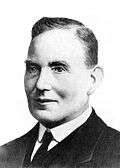James Nowlan

.jpg)
James Nowlan (1862[1] – June 1924) was the President of the Gaelic Athletic Association (GAA) from 1901 to 1921 and is the longest serving president of the organisation. He was also a Sinn Féin representative and member of the Gaelic League.[1] In 2009 he was named in the Sunday Tribune's list of the 125 Most Influential People In GAA History.[2]
Early life
Nowlan was born in Monasterevin,[1] County Kildare in 1862 and is listed in the local church as being baptised at Cowpasture, Monasterevin on 25 May 1862. His father, Patrick Nowlan, was an early member of the Irish Republican Brotherhood (IRB) and friend of James Stephens.[3] Patrick Nowlan was a cooper from Kilkenny city and possibly moved from there to work at Cassidy's Whiskey in Monasterevin.[4][2] James Nowlan also trained as a cooper.[5][6]
Career
Nowlan was a member of the Gaelic League, a lifelong supporter of the Irish language revival movement and a supporter of Sinn Féin from its foundation in 1905. In 1898 he was elected an alderman of Kilkenny Corporation.[1] He used his time in this position to help promote the GAA, which had been set up 14 years prior and was a relatively new organisation at the time.[1] In 1900 he became the first chairman of the Leinster Council of the GAA. He was elected President of the GAA nationally at the 1901 Congress held in September of that year.[1] He would hold that position for twenty years - making him the longest serving president.[5] During his time in office he attempted to steer the organisation on a more republican path.
Following the Easter Rising, Nowlan was arrested by the British in May 1916 and interned without trial in Frongoch, Wales.[1] In August of that year he was released and continued with his GAA and Sinn Féin duties.[1] He publicly voiced support for the Irish Republican Army during the Anglo-Irish War in the 1920s.[1]
At the 1921 Congress, held in March of that year, Nowlan retired as GAA President, and was appointed Honorary Life President of the association — the only person to be so honoured.[1]
Death and legacy
Nowlan died in June 1924 in his mid-70s.[1] Nowlan Park, the GAA stadium in his native Kilkenny, was renamed in his honour three years later.[1] He was buried in Glasnevin cemetery. While there was no headstone on his grave for some time, a Celtic cross was erected on his grave in 2013.[7] In September 2016 the GAA unveiled a new trophy named The James Nowlan Cup to be presented to the All-Ireland under-21 hurling champions.[8]
References
- 1 2 3 4 5 6 7 8 9 10 11 12 "James Nowlan, GAA President and Sinn Féin activist". 1169 And Counting..... 6–8 July 2003. Retrieved 1 December 2008.
- 1 2 Enda McEvoy, Kieran Shannon, Dave Hannigan (4 January 2009). "125 Most Influential People In GAA History". Sunday Tribune. Archived from the original on 9 August 2009. Retrieved 28 January 2009.
- ↑ Jim Walsh (2013). James Nowlan - The Alderman and the GAA in His Time. Independent Publishing Network. ISBN 9781782801993.
- ↑ "James Nowlan - who was he?". Kilkenny People. 13 December 2013. Retrieved 5 January 2015.
- 1 2 "GAA History > GAA Presidents". Official GAA Website. Retrieved 5 January 2015.
- ↑ "Household Return (Form A) - Residents of a house 2 in Troysgate (East) (Kilkenny Urban No. 2, Kilkenny)". National Archives of Ireland. 1911.
Listed as: Nowlan James, aged 47, Male, cooper by trade, relation to head of the house hold as Brother, religion listed as Roman Catholic.
- ↑ "Irish Press Releases - The Unveiling of the Headstone of Alderman James Nowlan GAA President 1901 to 1921". Press.ie. 2013-07-18. Retrieved 2013-08-28.
- ↑ "New All-Ireland U21HC trophy unveiled". www.hoganstand.com. Hogan Stand. Retrieved 7 September 2016.
| Sporting positions | ||
|---|---|---|
| Preceded by Micheal Deering |
President of the Gaelic Athletic Association 1901–1921 |
Succeeded by Daniel McCarthy |